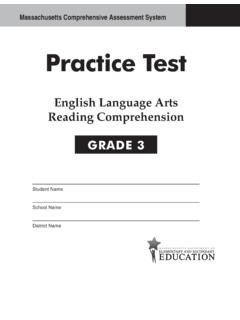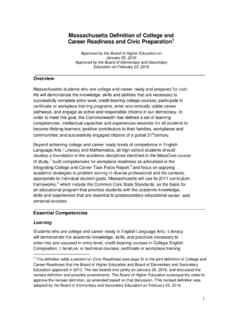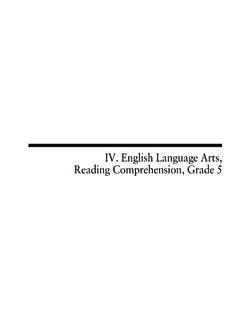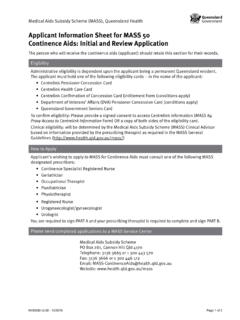Transcription of IEP PROCESS GUIDE - Massachusetts Department of …
1 IEP PROCESS GUIDE . June 2001. Massachusetts Department of Education address 350 Main Street, Malden, MA 02148. telephone 781-338-3000 internet INDIVIDUALIZED EDUCATION PROGRAM. PROCESS GUIDE . Table of Contents p Improving Student Outcomes 1. p Working Together 3. p About the Team PROCESS 5. p Making an eligibility determination is 6. the first step in the PROCESS . p Writing the IEP is 12. the second step in the PROCESS . p Making a placement decision is the third step in the PROCESS . 26. p Summary 28. Massachusetts Department of Education / June 2001. INDIVIDUALIZED EDUCATION PROGRAM. PROCESS GUIDE .
2 IMPROVING STUDENT OUTCOMES. Individualized Education Programs can improve student outcomes. The newly mandated Individualized Education Program (IEP) PROCESS and form is an important step forward in providing services to and improving outcomes for Massachusetts '. students with disabilities. The revision has fostered collaboration and has linked sound practice with statutory and regulatory requirements. The clear intent of the revision is to ensure that all students are challenged to excel, progress within the general curriculum and are prepared for independence in adult life, including post-secondary education and/or employment.
3 Not since the inception of the Massachusetts State Special Education Statute in 1972 has such a comprehensive revision been undertaken. IDEA-97 and the Massachusetts Education Reform Act of 1993 set the stage and support this critical undertaking. IDEA-97 leads educators to improve educational results. With the reauthorization of IDEA-97, the IEP PROCESS became unmistakably centered on these three key points: The involvement and progress of each child with a disability in the general curriculum including the addressing of the student's unique needs that are tied to the disability The involvement of parents, students, special educators and general educators in meeting the individualized educational needs of students with disabilities The critical need to prepare students with disabilities for independence and employment and other post-school activities.
4 IDEA-97 states that improving the educational results for children with disabilities is essential to ensuring equal opportunity, full participation, independent living and economic self- sufficiency. Massachusetts Education Reform Act sets high standards for all. The Massachusetts Education Reform Act of 1993 also set high standards for all students including students with disabilities. Education reform reinforces the need to assist all children to reach their full potentials and to lead lives as participants and contributors to the Commonwealth. The Massachusetts IEP PROCESS aligns with federal and state laws.
5 Massachusetts educators' approach to individualized educational programming must be revitalized to reach the goals set by IDEA-97 and the Massachusetts Education Reform Act. The following PROCESS GUIDE will lead you through the revised IEP PROCESS as well as suggest sound practices. This GUIDE should be reviewed along with mandated forms, notices and corresponding directions. Massachusetts Department of Education / June 2001 1. Please read each section carefully and consider how you might begin today to change your current practices. We believe the revisions are comprehensive and intensive.
6 We do not suggest a simple comparison with your current practice, but rather a full-scale rethinking of the PROCESS of finding a student eligible for special education and providing that student with appropriate services. Other guides are available to assist you. The Massachusetts Department of Education is producing other guides that may assist in realigning current practices. You may find the following documents helpful: GUIDE to Special Education Requirements Parent GUIDE to Special Education (produced cooperatively between the Federation for Children with Special Needs and the Department of Education).
7 About This GUIDE : We have designed this GUIDE to be read and reviewed with its companion document, IEP. Forms and Notices. We recommend a thorough reading of the IEP PROCESS GUIDE before familiarizing yourself with the aforementioned companion document. IEP Forms and Notices, therefore, should be read following this GUIDE . IEP Forms and Notices contains a quick reference sheet, form and notice directions and copies of the coded forms and coded notices. We believe that once you are familiar with the revised IEP PROCESS , you will more easily understand the use of the redesigned forms and notices.
8 We have graphically designed the two documents to help you easily cross reference one to the other. An icon has been developed to represent the three steps in the IEP PROCESS . You will first see this icon on page five of this GUIDE and then used repeatedly in IEP Forms and Notices. The icon becomes a visual link between form and notice use and the three steps of the IEP PROCESS described within this GUIDE . Additionally, we have used the codes from each form within this GUIDE 's section entitled About the Team PROCESS . The codes, to the left of text, connect the PROCESS description to a specific form(s) or specific form section(s).
9 After your first thorough reading of IEP PROCESS GUIDE and IEP Forms and Notices, you will be able to page through the GUIDE while easily referencing specified form(s) or form section(s). Similarly, the icon will help you connect form and notice directions back to the PROCESS description found within this GUIDE . Massachusetts Department of Education / June 2001 2. WORKING TOGETHER. IDEA-97 emphasizes a collaborative approach. The IEP requirements under IDEA emphasize the importance of working cooperatively as a team. The law expects school districts to bring together parents, students, general educators and special educators to make important educational decisions for students with disabilities.
10 With the combined knowledge and resources of these individuals, students will be assured greater support and subsequent success. Parents are equal partners in the Team PROCESS . The Team PROCESS should be a collaborative PROCESS between parents, school staff members and other professionals. Parents have a unique and critically important perspective on their child's learning style, strengths and needs. The school staff should ensure that parents feel welcomed and comfortable when communicating with school staff and at all meetings. Parents have the right to be involved in meetings that discuss the identification, evaluation, IEP.












